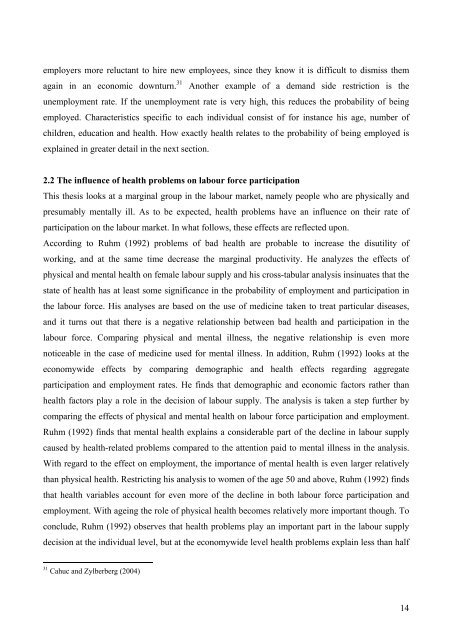An Analysis on Danish Micro Data - School of Economics and ...
An Analysis on Danish Micro Data - School of Economics and ...
An Analysis on Danish Micro Data - School of Economics and ...
You also want an ePaper? Increase the reach of your titles
YUMPU automatically turns print PDFs into web optimized ePapers that Google loves.
employers more reluctant to hire new employees, since they know it is difficult to dismiss them<br />
again in an ec<strong>on</strong>omic downturn. 31 <str<strong>on</strong>g>An</str<strong>on</strong>g>other example <strong>of</strong> a dem<strong>and</strong> side restricti<strong>on</strong> is the<br />
unemployment rate. If the unemployment rate is very high, this reduces the probability <strong>of</strong> being<br />
employed. Characteristics specific to each individual c<strong>on</strong>sist <strong>of</strong> for instance his age, number <strong>of</strong><br />
children, educati<strong>on</strong> <strong>and</strong> health. How exactly health relates to the probability <strong>of</strong> being employed is<br />
explained in greater detail in the next secti<strong>on</strong>.<br />
2.2 The influence <strong>of</strong> health problems <strong>on</strong> labour force participati<strong>on</strong><br />
This thesis looks at a marginal group in the labour market, namely people who are physically <strong>and</strong><br />
presumably mentally ill. As to be expected, health problems have an influence <strong>on</strong> their rate <strong>of</strong><br />
participati<strong>on</strong> <strong>on</strong> the labour market. In what follows, these effects are reflected up<strong>on</strong>.<br />
According to Ruhm (1992) problems <strong>of</strong> bad health are probable to increase the disutility <strong>of</strong><br />
working, <strong>and</strong> at the same time decrease the marginal productivity. He analyzes the effects <strong>of</strong><br />
physical <strong>and</strong> mental health <strong>on</strong> female labour supply <strong>and</strong> his cross-tabular analysis insinuates that the<br />
state <strong>of</strong> health has at least some significance in the probability <strong>of</strong> employment <strong>and</strong> participati<strong>on</strong> in<br />
the labour force. His analyses are based <strong>on</strong> the use <strong>of</strong> medicine taken to treat particular diseases,<br />
<strong>and</strong> it turns out that there is a negative relati<strong>on</strong>ship between bad health <strong>and</strong> participati<strong>on</strong> in the<br />
labour force. Comparing physical <strong>and</strong> mental illness, the negative relati<strong>on</strong>ship is even more<br />
noticeable in the case <strong>of</strong> medicine used for mental illness. In additi<strong>on</strong>, Ruhm (1992) looks at the<br />
ec<strong>on</strong>omywide effects by comparing demographic <strong>and</strong> health effects regarding aggregate<br />
participati<strong>on</strong> <strong>and</strong> employment rates. He finds that demographic <strong>and</strong> ec<strong>on</strong>omic factors rather than<br />
health factors play a role in the decisi<strong>on</strong> <strong>of</strong> labour supply. The analysis is taken a step further by<br />
comparing the effects <strong>of</strong> physical <strong>and</strong> mental health <strong>on</strong> labour force participati<strong>on</strong> <strong>and</strong> employment.<br />
Ruhm (1992) finds that mental health explains a c<strong>on</strong>siderable part <strong>of</strong> the decline in labour supply<br />
caused by health-related problems compared to the attenti<strong>on</strong> paid to mental illness in the analysis.<br />
With regard to the effect <strong>on</strong> employment, the importance <strong>of</strong> mental health is even larger relatively<br />
than physical health. Restricting his analysis to women <strong>of</strong> the age 50 <strong>and</strong> above, Ruhm (1992) finds<br />
that health variables account for even more <strong>of</strong> the decline in both labour force participati<strong>on</strong> <strong>and</strong><br />
employment. With ageing the role <strong>of</strong> physical health becomes relatively more important though. To<br />
c<strong>on</strong>clude, Ruhm (1992) observes that health problems play an important part in the labour supply<br />
decisi<strong>on</strong> at the individual level, but at the ec<strong>on</strong>omywide level health problems explain less than half<br />
31 Cahuc <strong>and</strong> Zylberberg (2004)<br />
14
















